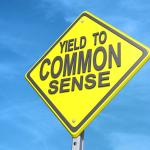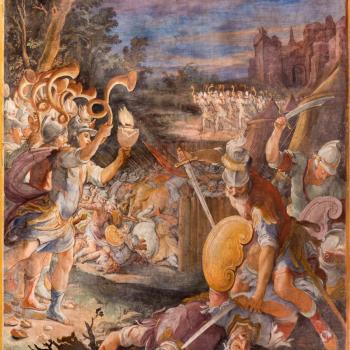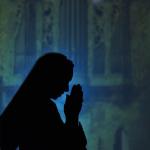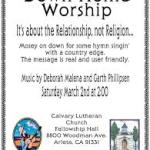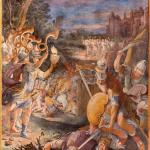Since the late 17th century, the defense of the Christian faith has primarily been made with respect to the veracity of its claims. With the emergence of modern philosophy, however, and the great emphasis in the West on natural science as the main, if not sole, source and arbiter of truth, Christian apologists since the time of Montaigne have had to demonstrate the rationality of the Christian faith using evidence and arguments. While this line of rational apologetics goes further back to the medieval scholastic theologians, Anselm and Aquinas most prominently, in the modern era (roughly 1650-1950) Christian philosophers and historians have worked to demonstrate the coherence of a Christian metaphysics and the knowability of its claims.
This “classical apologetics” has focused on two central areas of Christian belief: the existence of God and the historicity of the Resurrection of Jesus Christ. Almost all Christian apologetics from the time of Leibniz to Swinburne, or from Paley to Wright, have concerned themselves with these two themes: the likelihood of God’s existence and the probability of Jesus’s Resurrection. However, in recent years there has been a noticeable shift in the culture and, as such, the need for a different kind of Christian defense.
From Modernity to Post-Modernity, Or From Arguing God’s Existence to His Goodness
While truth claims about God and the Resurrection, and claims tangential to each, remain major foci for apologists, recent decades have brought new challenges. These challenges have come from those not only interested in the truth of such claims, but also in whether or not Christian claims, were they true, would indeed be “good news.” The shift from questioning God’s existence to questioning His goodness was noticeable at the dawn of the new millennium, and reminiscent of more ancient attacks against Christianity, like that of Marcion.
The so-called New Atheists, unlike their more mild-mannered, 20th-century predecessors (Russell, Quine, and Flew, for example), were interested not only in attacking the classical loci of Christian belief. They were also keen to point out the horrible character of the biblical God as well as the deficient moral teachings of Jesus of Nazareth. Christopher Hitchens and Richard Dawkins, among others, were noteworthy for their direct attacks on the character of God. Their criticism went beyond the more dispassionate assessments of whether or not God exists by the prior generation. The idea was that even if this biblical God were real, you wouldn’t (or shouldn’t) want to worship Him. And this would include any loyalty to His so-called “Son,” Jesus Christ. Hitchens eagerly reminded Christians that their Jesus was anything but the “gentle Jesus meek and mild” of children’s storybooks or Veggie Tales. He is as much a cruel prophet with constant threats of hellfire on his lips as He is a good shepherd.
These contemporary challenges against God’s character, which led to large-scale political movements like “The Freedom from Religion Foundation” and other atheistic initiatives aimed at reducing America’s religious footprint. They have, however, floundered in recent years, for two reasons., First, robust Christian responses to intellectual challenges have put atheists materialists on their heels. Second, however, is the image of angry, white men who hate God that has had a negative sociological effect on the new atheism, one the new atheists likely could not have predicted. As such, Daniel Dennett’s (one of the “Four Horsemen” of the New Atheism) call to create a new society of “Brights,” does not look to have a very bright future. Instead, there is a new wave of anti-Christianity in town, one as much at odds with atheistic materialism as it is with the Bible.
This Ain’t Your Babushka’s Marxism: Post-Modernism and The Return To Religion
Black Lives Matter is not your traditional Marxist organization. While founders Patrisse Cullers, Opal Tometi and Alicia Garza openly admit to their “Marxist training,” the ladies who started the most effective socialist organization in recent years are a far cry from the lab-coated Russian Marxists of the 20th century. Unlike their white European, heteronormative, materialist predecessors, the founding mothers of BLM are quite open to alternative spiritualities and religion. Various BLM chapters have teams explicitly designated to conduct spiritual operations, a movement that would have been utterly crushed under the likes of a Brezhnev or Khrushchev.
Here is a description taken directly from the BLM chapter of Los Angeles:
Black Lives Matter is much more than a racial and social justice movement, it is rooted in Spirit. Like each successful iteration of Black freedom struggle, Black Lives Matter draws deeply from spirituality and the path forged by our mightiest Ancestors. The Sacred Resistance Team was built following the installation of the 45th President of the United States in 2017, recognizing that the toppling of the White-supremacist-patriarchal-heteronormative-capitalism that he embodied requires significant Spiritual work. Sacred Resistance is an interfaith effort that utilizes Spiritual tools and practices to advance justice.
There is a theoretical reason for this neo-Marxist turn toward spirituality: Critical Theory. Critical Theory, or CT, of which Marxism is one form, has advanced along different intellectual pathways in the West over the last several decades. This is especially the case in critical theories about gender and race, and perhaps, to a lesser extent, class. With regard to critical race theory, for example, one main line of thought that can be found throughout the academic literature is the idea of deconstructing “Whiteness.” This thing, “Whiteness,” has some identifiable properties, properties that must be challenged on a CRT view of culture and society.
“Whiteness,” according to critical race theorists, is an ideology born mainly out of two corresponding movements: the colonization of aboriginal lands by European invaders and the European Enlightenment. This cultural mode of European Whiteness, according to CRT, possesses distinct intellectual features. These features, or so it is claimed, have only harmed humanity and, therefore, they must be weeded out of western institutions. Further, it was this same ideology of Whiteness which informed the intellectual life of the founding fathers of the United States. It was out of Whiteness that they conceived a nation that was inherently racist in orientation and whose institutions, in their inception, were grounded in supremacist thought.
I have written elsewhere in detail about the intellectual features of “Whiteness” critical race theorists claim are distinctly European in origin. I have also spoken about how erroneous this claim actually is and pointed out some of its implications with regard to a historic Christianity. However, there is one aspect of “Whiteness” that is particularly relevant to the discussion at hand, which is the need for a new Christian apologetics. It is a feature of European Whiteness that relates directly to nature and human spirituality, and which usually goes by the term “desacralization.”
The European “Desacralization” of Nature
Critical race scholar, Kenneth B. Nunn, provides an explicit account of this “typical” feature of white Eurocentricity. In listing seven primary attributes of “Eurocentric” cultural thought (features like “analytic thought” and “extreme rationalism”), Nunn concludes with the feature of desacralization. He states:
Nature objectified and rationalized leads to the illusion of a despiritualized universe. In the Eurocentric world-view there is no room for the operation of sacred forces. Nature is reduced to a mere thing, an object that may be manipulated to suit mankind. This is a perspective that is almost uniquely European. Even where God is allowed in Western philosophies, s/he is banished to a separate spiritual realm where s/he can have no effect on quotidian human affairs.
Nunn, Law as a Eurocentric Enterprise, 337
Certainly there is a ring of truth in Nunn’s indictment of the generic deism or atheist materialism that emerged out of the European Enlightenment. Many Christians may be tempted to give a hearty “Amen” to Nunn’s criticism, and even to find common ground, of which there might be some. However, in decrying desacralization, Nunn and other CRT advocates have tipped their hand as to their true intention (and their true enemy). CRT advocates like Nunn, or activists like Tometi, Garza and Cullors, are not only interested in repopulating the world with “sacred forces,” something that scares the daylights out of the Richard Dawkins or Bill Mahers of the world. It is more than just that. Critical theorists are interested in reanimating the sacred forces in nature.
Thus, the historical and ideological opponent of the critical race theorist is not only the über-rational atheist materialist, it is the traditional Christian. Why? Because traditional Christianity, actually Judaism, is the real root, the ultimate source, of the process of desacralization.
Critical Theory, The Bible and The Charge of Desacralization
Nunn’s critic is not just against European culture in general. Whether Nunn would admit it or not his attack against the “desacralization” of nature by European colonialists is not just an attack on European ethnicity or intellectual development. It is an attack on the theology that underlies European culture–it is an attack on the biblical view of the natural world.
In his commentary on Genesis, Jewish scholar Nahum Sarna points out the clear teaching of the Hebrew Bible as it applies to the most fundamental metaphysical principle of Hebrew theology, namely, the stark distinction between the Creator and the creation. Commenting on Genesis 1:11, Sarna says:
This creative act [letting the earth sprout] constitutes an exception to the norm that God’s word directly effectuates the desired product. Here the earth is depicted as the mediating element, implying that God endows it with generative powers that He now activates by His utterance. The significance of this singularity is that the sources of power in what we call nature, which were personified and deified in the ancient world, are now emptied of sanctity. The productive forces of nature exist only by the will of the sovereign Creator and are not independent spiritual entities.
Sarna, Genesis, 9
In addition, the French sociologist and theologian, Jaques Ellul, highlights the same biblical theme that exists throughout the Old and New Testaments. Nature is, according to the Scriptures, not divine. It is the product of divinity, the effect of the Creator, but it is not itself sacred. As such, nature apart from God is just dead matter. This claim is not novel to Christianity, it is a fundamental assertion of all Jewish theological thought:
It [desacralization] took place at two levels and in two different periods, first in the thinking of Hebrew theology, then in its Christian development. Everyone knows that in the Jewish Bible, whether in the Pentateuch or the prophets, there is a violent attack on the religions. Often this is viewed very simplistically as a battle of religions. This is not at all the issue. If fact, the battle is against the sacred.
The gods that are resisted and rejected are the gods of nature: the moon goddess, the god of reproduction, the god of thunder, etc. It is a matter of regarding natural things or forces as things or forces that have nothing sacred about them. God is not in these realties; they are purely natural realities. One of the features of the Hebrew text is that it abounds in irony that is designed to show that the sacred powers of nature do not exist.
Ellul, The Subversion of Christianity, 55
In sum, while one might read Nunn and his colleagues as merely attacking the deistic “god of the philosophers” who seems uninvolved or uninterested in human affairs, the act of the desacralization of nature can nevertheless be interpreted, quite fairly, as the Christian missionary attempt to turn pagan cultures from their divinized gods of nature to the one, true Creator of nature– to the God of the Bible. Ellul goes on:
Everything is purely and simply creation. That is to say, everything is simply an object or thing. If it comes from the Creator, it contains nothing of its divine origin, no mystery, no hidden power. The wood is made of wood; it is not the home of Pan or of goddesses. Water, the source of the ocean, is water–and nothing more. The moon is a luminary by which to measure time. Biblical creation is totally desacralizing because it is in no sense a theodicy….God speaks his word, and things are. This is all. What this means it that God is truly outside the world, that he is totally transcendent. He is not enclosed in any part of this creation. He is beyond it.
Ellul, 56
I doubt that the founders of BLM are sympathetic to this deeply Judeo-Christian idea of desacralizing the spiritual forces of nature. Nor do I think theorists like Kenneth Nunn would be friendly toward Ellul’s (correct) theological analysis of the Creator-creation distinction, a distinction drawn directly from St. Paul’s proclamation at the outset of his letter to the Romans (see Romans 1:18-32). However, it is not just critical race and gender theorists who seem to be embracing a return to the sacralization of nature. There seems to be movements within the visible church itself suggesting that the pagan gods are once again making inroads into the Community of Faith.
Evidence of RE-sacralization
If the Bible and the Judeo-Christian theology that informed all of European history from at least the time of Charlemagne is the real culprit when it comes to the “desacralization” of nature, and if this is what critical theorists are ultimate attacking, then what might be the ultimate hope of critical theorist when it comes to man’s relationship to nature? Moreover, is this movement making inroads in the Church?
It seems there is emerging evidence, global evidence, that a movement toward the “re-sacralization” of nature is occurring in the church itself. One line of evidence for this infiltration is the growing notion among Catholics and Evangelicals that all the pre-colonial folk religions which were evangelized by either the Catholic Church or by Protestant missionaries are equal in status and value as the historic Christianity that was brought to them by those missionaries.
The most egregious example of this reevaluation of pagan religion was on display in the Vatican itself, during the 2019 Amazon Synod held in Rome. During the three week synod, effigies of the ancient goddess “Pachamama” were placed in a side altar of the Roman Catholic church of Santa Maria della Transpotina and prayed to openly– a seemingly overt act of idolatry. In addition, a sacred pagan dance to Pachamama was held in the Vatican gardens, as a sacred tree was planted in its grounds. Finally, and most egregious to Catholics of good faith, at the final mass of the Synod, sacred dirt dedicated to Pachamama was placed on the altar of St. Peters Cathedral next to the very elements of the Eucharist (in Catholic theology the literal body and blood of Christ). Could there be a greater confusion of the Creator-creature distinction than this (especially given the Roman Catholic view of transubstantiation)? It seems hard to imagine!
But if Evangelicals who stand in the historical lineage of the Reformers, who saw themselves as purging from the medieval Church its many sacralizing accretions, think they are safe from falling into the contemporary trap of re-sacralization, they should think twice. While it may be right and good to call out aspects of historical missionary work that were clearly deficient, like the “Doctrine of Discovery,” it is often a short pathway from calling out particular failures of the Church in its Great Commission, to questioning the validity of the Commission itself. But to question the evangelism of the nations is not to put the Church to the test, it is to put Jesus Christ on trial (Matt. 28:16-20).
Paganism and the Power of God
Aboriginal religions clearly have a more sacralized view of nature–most of them being forms of animism or pantheism. If intellectual movements like CRT in the West are helping to re-open the doors to the ancient gods, then there will be another major shift in the Church’s apologetics, especially as biblical Christianity weakens in the West. The rise of neo- paganismin the West is not just due to critical theories, however. It is a natural return of man who is, at heart, homo religiosus, “man who worships.” There is a quote, usually ascribed to G.K. Chesterton, that sums up this truth:
When a man ceases to worship God, he does not worship nothing but worships everything.
G.K. Chesterton (maybe)
But man needs more than abstract things to worship, like numbers, or even concrete things, like money. Human beings are designed to worship that which is somehow above them, but which is also personal in nature. If they do not enter into relationship with God (who is ultimate in both aspects), they will find a lesser, but similar, replacement. So it would be natural to homo religiosus to return to the gods of his pre-Christian ancestors. And this is what we will soon see explicitly in the Western world, much to the chagrin of the New Atheists. But for Christians we are not without a precedent in how to deal with a pagan world, even if it manifests itself in modern packaging.
A New Apologetic?
While confronting paganism is a very different challenge than the scientific materialism of the 19th and 20th centuries, or the current strain of post-modernism, it is nevertheless a confrontation more natural to the Christian worldview. After all, this challenge has already been faced by the Church, albeit nearly 1800 years ago. As such, it is not a novel challenge to the Christian faith. It is just one we have not seen in some time.
Although this is speculative, it is my belief that the next major shift in Christian apologetics, therefore, will have less to do with the sheer existence of God (that will be taken for granted), or even with His goodness. What will matter in the confrontation with a neo-pagan society will be whether or not God is powerful. Is the God of the Bible, the Trinity, the God Who has real power? Is God at the top of the ontological food chain, to use a casual metaphor. For theologians this will push God’s attribute of omnipotence to the forefront of our apologetic.
If this shift is really happening, and I think it is, then we will soon find ourselves moving out of the more rational and psychological spaces in which we have been conducting our apologetics and into more direct confrontations of will and power. We will likely shed our classical apologetics approach, to some degree, in favor of a more prophetic mantel:
Your right hand, O Lord, glorious in power,
your right hand, O Lord, shatters the enemy.Exodus 15:6
A return to the pagan gods means a return to the question: “Who (not what) is mighty to save?” That is a question that we have a very clear answer to as Christians, and one that probably will not even require us to use Bayes’ Theorem. Instead we might be called to take up a literal axe, like St. Boniface, and cut deeply into the sacred tree of Thor. In fact, prophetic actions like these are already taking place. Given the kinds of things we are seeing at home, especially in places like California, and abroad, it could be the case that instead of tearing down arguments, we may have to start tearing down altars.




